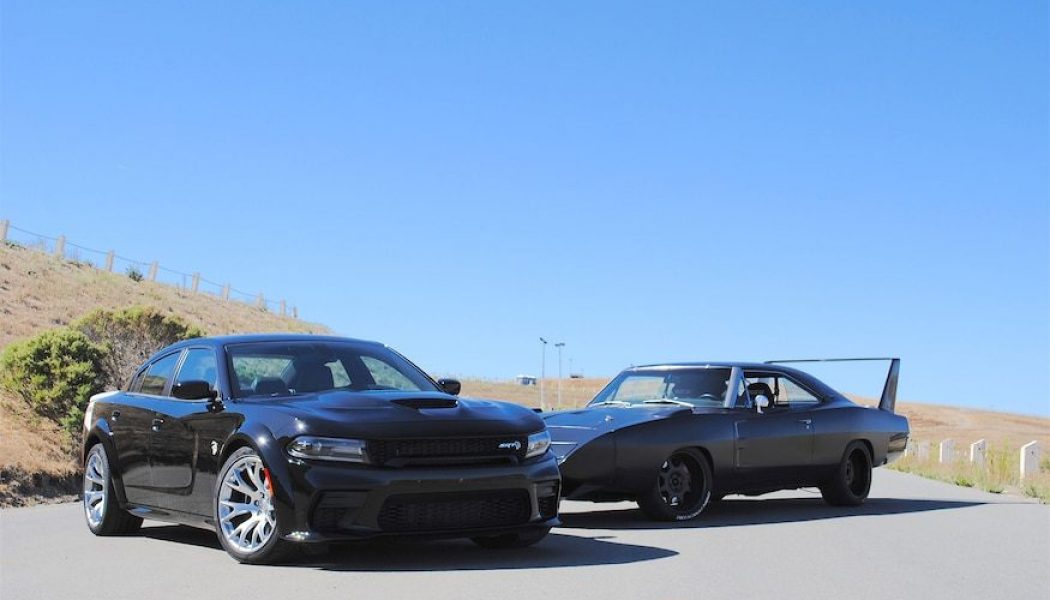The 2020 Dodge Charger Daytona 50th Anniversary Edition is a marketing stab by the folks at FCA that capitalizes on the lunacy that was the original 1969 Daytona. As an homage to the original car, only 501 of these 717-horsepower beasties will be produced, a number that is supposed to mirror the 1969 production numbers.
I miss having automotive heroes—those cars and trucks that, after flipping through the pages of the old buff books, would capture my imagination. Back then, I knew every option and engine code on every vehicle from nearly every manufacturer. Yet now, with the deluge of information we get via social media, I don’t commit as much to memory anymore. Today’s automotive culture is changing at a rate that’s faster than any modern-day vehicle. And while some OEMs are infusing as much technology as they can into their new models to lure buyers, others like Dodge are still counting on excessive power numbers (and a bit of nostalgia) to carry them through the next few years.
I’m a fan of the 1969 Dodge Charger Daytona, so much so that back in 2007, we built a clone out of a 1969 Charger SE. From a body perspective, it was made to exact 1969 specifications down to the nosecone, flush rear window, and the trunk braces that help secure the massive rear wing (and yes, you can stand on it). However, that’s where the similarities end. With custom one-off wheels, brakes lifted from a third-gen Viper, a five-speed manual transmission, and a 471-cubic-inch stroker with Holley EFI under the hood, the car is now more pro touring than stock. Once complete, we proceeded to crisscross the United States multiple times, run it in rallies, drag races, and even hit the occasional track day. To date, I’ve racked up close to 50,000 miles on the old boy with no plans of slowing down.
If you stop and think about it, the original Daytona is what a race car might look like if a seven-year-old designed it today, yet back in 1969, it was cutting edge. Penned by the late John Pointer, an engineer who worked at Chrysler’s missile division (yup, Chrysler used to make rockets), the Daytona employed technology never before seen on a race car. The outrageous nose cone and rear wing kept the car planted on the tarmac by forcing clean air up and over the body and thus helping it to achieve speeds of 200+ mph. To the public, the car looked like a spaceship, but to a rocket development engineer, it made perfect sense. And, hell, Chrysler didn’t care what the damn thing looked like as long it won races, which it famously did.
The new 2020 Charger Daytona has never been raced a day in its life, nor was it designed to be. Is it fast? God, yes. Does it handle? Absolutely. Will it reach icon status and be collectible? That one has yet to be seen.
What we do know is that the 2020 Dodge Charger Daytona might be the last great muscle car to come out of Detroit, and I say that looking at the vehicle through the eyes of an enthusiast who grew up around carbureted big blocks. The evolutionary process of the Charger has been impressive to watch. Back in 2006, the original Charger SRT8, with its potent 6.1L HEMI V-8, produced 425 bhp and 420 lb-ft of torque through a five-speed automatic transmission. Though a manual option was never offered, buyers of the new four-door muscle sedan didn’t seem to mind.
Underneath the wheel arches sat a 245/45/20-series tire up front, with a 255/45/20-series tire in the rear. The brakes consisted of large two-piston Brembo calipers on 14-inch rotors, and from a handling perspective, the old Charger SRT8 would pull 0.87 g on the skidpad. It would also hit 60 mph in 5 seconds flat and top out at 165 mph. Average by today’s standards, but downright impressive 14 years ago.
This 2020 Dodge Charger Daytona is a 50-year throwback to when the original ground-pounding muscle cars of Detroit ruled the streets, and to when cubic inches were more critical than touchscreens. For the Daytona, the designers and engineers took a different approach to the latest trends and went full-on bionic by making it bigger, faster, and stronger than their closest competitor (of which, there are none). Each supercharged 6.2L HEMI gets a bump in power from 707 to 717 horsepower via a revised powertrain combination, along with a unique rear spoiler, dash plaque, and rear Daytona graphic.
Public: “But, Mike, the platform is old. It’s been around for 14 years, and we want NEW, NEW, NEW!”
Folks, get over yourselves with that train of thought, as the Charger was on pace to lead the U.S. large-car segment for three years running in 2019 in terms of sales.
With 3.5 inches of additional width, the 2020 Charger Daytona Widebody now sports 20 x 11-inch rims that wear 305/35-series Pirelli tires at all four corners, and for the first time, electric power steering (EPS). The changes don’t stop there. Underneath that stunning bodywork is a revised version of the SRT-tuned Bilstein three-mode adaptive damping suspension. The changes consist of stiffer springs (32 percent stiffer than previous models), larger sway bars (expanding from 32mm to 34mm in the front, and 19mm to 22mm in the rear), along with retuned shocks with revised valving.
This translated to improved performance across the board from the narrow-bodied car. Handling has gone from 0.94 g on the skidpad to 0.96 g, with a 0.84-second improvement in quarter-mile time (10.96 from 11.8). Although the top speed on the Hellcat has dropped from 204 mph to 196 mph (those flares do cause drag), the 0-60 mph time has improved slightly from 3.7 seconds to 3.6. Massive 15.4-inch two-piece front brake rotors with six-piston Brembo calipers and four-piston rear calipers have also enhanced the 60-0 stopping distance to 107 feet, an improvement of 4 feet. Flares aside, there’s also a new mail-slot-style grille to aid with cooling, a redesigned rear spoiler, new fender badges, and beautifully integrated rocker moldings. As of right now, no official performance numbers have been listed for the 2020 Daytona, but we expect that 10 extra horsepower won’t make much of a difference over the standard Widebody Hellcat.
Get the Daytona out on the road, and you’ll immediately succumb to the fact that driving this car is akin to wearing your favorite jeans. There’s a familiarity about it that makes you feel at home. Until, that is, you step on the throttle and realize the 717 bhp and 650 lb-ft of torque means you can tow your home to the next state. It’s blisteringly fast, and thanks to the larger wheels, tires, and improved suspension, there’s a confidence and a handling balance that didn’t exist before. As a whole, the car feels more composed and is far more manageable when driven aggressively. Having said that, it is still a substantial vehicle with a 120.0-inch wheelbase and a curb weight of more than 4,500 pounds, so while the handling is improved, don’t go thinking that you’ll be running down sports cars. That won’t happen.
The cabin represents an excellent combination of sport and technology, even though some of the materials are dated. The seats have gone mostly unchanged since the original SRT8 debuted back in 2006, except for the addition of Nappa leather surfaces and updated patterns. They’re some of the best in the class and offer great lateral and lumbar support along with heat and ventilation. The leather-wrapped, flat-bottomed steering wheel has excellent hand feel, and the T-handle shifter pays homage to the Dodge and Plymouth cars of the ’70s.
Uconnect 4C not only handles in-car functions such as navigation, climate, and audio, but it also gives one access to the SRT Performance Pages, launch control settings, and overall vehicle diagnostics. Here you can configure transmission and suspension setup, power output, and steering feel. From a materials standpoint, the Charger only scores about midway up the scale. However, in an attempt to add a bit of luxury, 2020 brings with it a new carbon and suede interior package that does bump it up a notch.
The automotive world is rapidly changing. Autonomy is coming, as is a lack of privacy, anonymity, and freedom. The 2020 Charger Daytona is still a blunt instrument. It’s still raw, powerful, and at times, unruly. It doesn’t care about traction or stability control (even though it has them), nor does it seek to impress anyone but the individual behind the wheel. It’s unapologetic and raw. More importantly, it’s still unabashedly a muscle car with no equal. At $74,140.00, it’s not cheap, unless, of course, you consider that the closest competitor costs more than six figures.
In my eyes, the original 1969 Dodge Daytona etched its way into the history books because of its achievements on the racetrack, not showroom sales. Aside from its Plymouth Superbird sibling, no other American manufacturer has ever sold anything to the public that was so outlandish, except maybe the quarter-mile-killing, 840-bhp 2018 Demon. Who knows, maybe one day that engine will find its way into a Charger, and instead of being a quarter-mile king, we’ll see it blitzing the full mile at a rate never before seen by an American production vehicle.
While the adult in me can’t help but feel fortunate to live in a time where 200-mph sedans exist, the kid in me is still hoping that one day, before the current-generation Charger departs, we’ll get one last hoorah that will allow it to etch itself into history, just as its great-grandfather did 50 years ago.
Photography by John McGann










